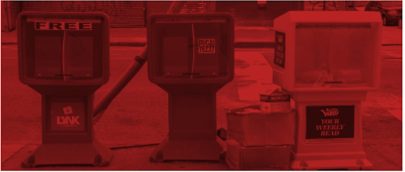Policy Menu
There are quite a few different encouraging public policy proposals that could help rebuild local news. Each of the ones we mention below could be implemented on the state or local level in a way that follows our principles for sound policy making. These are geared toward ensuring that public policy is nonpartisan, content-neutral, platform neutral, and future friendly.
Small Business Advertising
Examples: Wisconsin, Colorado, Maryland, Federal Community News and Small Business Support Act
Pros: Decisions about who benefits would be made by businesses, not government officials. Bipartisan support.
Cons: Small businesses will pick the news outlets that they think will deliver on their marketing goals best, which means the benefits could be unevenly distributed in a community.

Consumer Subsidies
Example: Local News Funding Act of 2025 in Washington, D.C.
Pros: Encourages reader revenue, boosts civic engagement, and avoids direct government selection of outlets.
Cons: Requires administrative infrastructure to vet and track eligible outlets. Without a resident co-pay, it could be vulnerable to coordinated political misuse.
The other approach is a subscriber or donor tax credit to consumers who subscribe or donate to a local newsroom.
Examples: Massachusetts bill, federal LJSA
Pros: Encourages direct financial support to local outlets, like the voucher model.
Cons: Benefits may disproportionately go to wealthier individuals who itemize or already subscribe, limiting its reach to new readers.
Fellowships
Examples: California, New Mexico, Washington, Illinois
Pros: Direct help to shore up journalism jobs throughout the state. Picks newsrooms rather than reporting projects, which helps make it more First Amendment friendly.
Cons: May not encourage business model sustainability. Involves state government body deciding who gets the fellows.

Grants
Examples: New Jersey
Pros: Can more precisely target aid toward news deserts and underserved communities. Can also incentivize local philanthropy to increase their support of local news outlets.
Cons: Involves a government-chartered body making subjective judgments about what projects are most worthwhile. If not carefully constructed, could lead to political favoritism, perceptions of bias and erosion of trust.
SUPERSIZE NEWSMATCH
Use cases: There is already infrastructure for Newsmatch, this would just augment what already exists.
Pros: Piggybacks on an already established, well-respected mechanism. Few subjective content judgments.
Cons: Newsmatch rewards newsrooms that already have some fundraising capacity.
Community News investment Fund
Pro: Encourages sustainability and local control.
Cons: If organizations don’t develop sound revenue models, they won’t be able to pay back the loan.

EMPLOYMENT Tax Credits
Examples: Federal Community News & Small Business Support Act, New York, Illinois, New Mexico
Pros: Significant direct support to newsrooms, but targeted toward the heart of the problem — falling rates of newsroom employment.
Cons: Involves a degree of government oversight in some edge-case decisions about what counts as an eligible news outlet and could subsidize “pink slime” newsrooms that have local reporters.
Government Advertising
Examples: New York City, Chicago, Connecticut, San Francisco
Pros: Involves no new spending (a plus in tight budgetary times).
Cons: News organizations must prove that advertising with their outlets will be as effective as the advertising strategies previously used by the government. If poorly constructed, it can provide elected officials with a dangerous ability to reward and punish local press.

BROADBAND DEVELOPMENT
So far, Rebuild Local News has submitted letters to about a half dozen state broadband and digital equity authorities, encouraging them to include local news outlets in their digital equity plans.
Replanting
Example: Illinois, California, Connecticut, Maryland
Pros: Helps keep local papers in local hands. May prevent further consolidation.
Cons: Affects a relatively small number of publications. May also require incentives for the chains to sell.

LOAN FORGIVENESS FOR JOURNALISTS
Use cases: The federal government already has student loan forgiveness for certain kinds of federal service — this program would simply scale that policy to make local journalism jobs more accessible.
Pros: Could help journalists stay in local journalism jobs, some of which tend to be lower paying, longer, and make it easier for people from non-wealthy backgrounds to remain as in the field.
Cons: If it applies to all local reporters (and not just those working at nonprofit organizations), it would require a massive government effort to define who was eligible.





